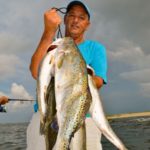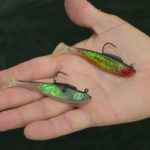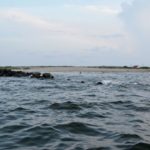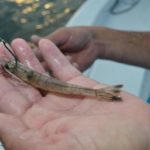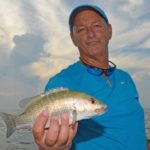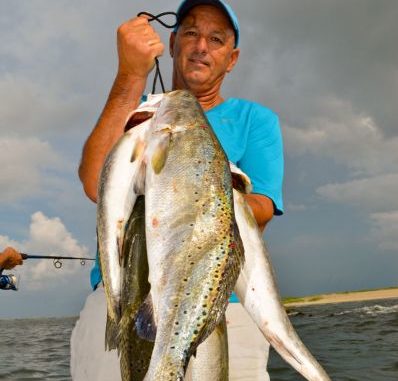
Most big-trout anglers carefully hide their hotspots, refusing to give other anglers clues to their successes. But this angler gave up his secrets to summertime Grand Isle lunkers.
“He is consistently catching large fish. I haven’t seen anyone enjoy the success that he has. It is nothing short of miraculous.” Patrick Bonin, Internet managing editor of Louisiana Sportsman.com.
“He’s one of the hottest things going. He’s always been a great trout fisherman in the Grand Isle area. He can fish live bait and he can fish artificials.” Gary Rispone, host of Paradise Louisiana video magazine.
I had been hearing about this guy at Grand Isle who was catching a lot of big speckled trout. He was popping up all over on the Internet, and a lot of people were talking about him.
Grand Isle isn’t noted for big trout. And it certainly doesn’t produce many in August (a small-trout month) and February (a no-trout month).
So I called Buggie Vegas, who with his wife Dodie runs Bridge Side Marina.
“Yeah, I know Carl Vidrine,” he replied. “He fishes out of here. He has a horseshoe up somewhere!”
Over the phone, I could visualize Vegas shaking his head.
So I gave the 49-year-old supposed trout prodigy a call. I wanted to see if he really was such hot stuff.
Thomas Carl “Tommy” Vidrine wasn’t shy at all. Over the phone he came across just as he did in person later — self confident, a little bold, but all without being obnoxiously cocky.
After we set up the trip, I thought to myself, “Well, every dog has his day. Let’s see how he does in the dog days of August, the worst big trout month of the summer for in Grand Isle.:
And when Vidrine told me how early he wanted to launch, I sighed to myself.
“Oh, we’re in for a long ride,” I thought.
The long ride wasn’t unexpected. I fully expected that he would be hauling my carcass to some secret spot far, far away from civilization where only the boldest, most-intrepid fishermen would go.
Nothing much was stirring at the Bridge Side Marina at that hour, even though it was August and still a busy fishing month. I hunched over, kind of scootled my chin down in my shirt, and closed my sleepy eyes.
I tried to catch a nap while Vidrine idled the boat out of the marina. I heard him throttle the boat up on plane.
Two minutes later, he cut the big engine to an idle and the boat squatted down in the water.
“Huh? Are we broke down? What’s wrong?” I mumbled and opened my eyes.
I couldn’t see nuttin’. It was pitch black.
“No, we’re here,” he replied.
“You gotta be kiddin’ me,” I fired back. “Where are we?”
“The rocks at Caminada Pass,” he answered as he shut the big engine off and moved to his trolling motor on the bow.
“Something isn’t right here,” I thought. “This spot is so close to the marina we could have trolled the boat here. Everyone knows about the rocks at Caminada Pass — this isn’t a secret spot. Why would he bring me, an outdoor writer who will spill the beans about his secret spot to a place so easy to find?”
I kept my questions to myself.
Fortunately.
As he jockeyed the boat closer to the rocks, he explained that we would be fishing the end of the short Caminada Pass rock jetty and he wanted the boat to be perfectly positioned. He left so early because he didn’t want anyone to beat him to the one tiny anchoring spot that would put him in position for perfect casts.
The small beacon off the end of the rocks was the only visible guide he had to position the boat in the darkness. When he felt he was in exactly the right place, he eased the boat’s anchor overboard.
“I get here before daylight,” he cooed in his honeyed silk salesman’s voice, “because by daylight there will be boats all around us.
“They won’t be catching fish like I will; I will have position.”
It was still dark and a long time until daylight.
He went on to explain why the spot works.
“At the end of the jetty there are some big rocks that have tumbled down. They are underwater — big rocks,” he said. “I saw them when I dove down to untangle an anchor.”
The spot is best on an incoming tide, and his theory is that the combination of the tide pouring in and the wave action from beach rollers slams bait species around the submerged rocks, making them easy prey for big, lazy trout.
Still well before daylight, he fished a shrimp out of the bait well, put it on his hook and flipped it near the water that was foaming over the rocks at the jetty’s end.
The response was quick, but the trout was under 2 pounds. Not what he was looking for, but still a very respectable Grand Isle trout for August.
“Shrimp are my first choice for fishing here — the bigger, the better,” he explained as he rebaited, this time with a croaker. “I fish big fish. For a volume of fish, you would probably want a medium-sized shrimp.”
For a few more casts, he shifted back and forth between jumbo shrimp and croakers, but the croaker bite was definitely slower and the trout weren’t any bigger.
Slightly after daylight he shifted totally to shrimp and stuck with them the rest of the short morning.
The improving light revealed his tactics.
After casting, he let the bait sink 4 or 5 feet before engaging the reel. He watched his line closely.
When he felt the thump of a fish taking the bait in its mouth, he didn’t strike immediately. Instead he allowed the trout to swim with the bait, and when he felt what he called “a nice pressure” he picked the rod tip up and began to crank the fish in.
“I let them swim with the shrimp for two or three seconds,” he explained. “With croakers I let them swim longer, maybe five seconds.”
The incredibly sharp hooks he uses allows him the luxury of not having to make a strong hook set.
Daylight also revealed a scene of teeming life. Large shoals of mullets navigated the water’s surface round and round the boat. Shrimp jumped and popped on the surface constantly as the water swooshed onto the rocks.
Several times the hooked shrimp on Vidrine’s line came to the top, chased by a crazed trout. The sight of the trout trying to eat his bait understandably excited Vidrine.
Good daylight also brought truth to Vidrine’s prediction: Boat after boat pulled up on him.
One particular boat with a solo operator particularly stood out.
His boat came in hot — no trolling motor approach here. He slammed it in reverse, ran to the bow of the heaving boat and noisily struggled to untangle his anchor.
The boat drifted too far toward the rocks. In a panic, the man ran to the controls and revved it in reverse.
After reversing it in a complete circle, he ran to the bow before realizing that he had overshot his mark.
After making another approach with the big motor, he finally and noisily got the anchor overboard.
Vidrine sat stoically, taking it all in without making a face or a comment.
When the fisherman in the boat began fishing, he paid far more attention to what Vidrine was catching than to his own line. The envy plainly showed on his face as Vidrine levered in trout after trout.
Frustrated, our unnamed hero pulled his anchor and cranked his motor to move the boat — but apparently unable to control his rig, he drifted right over the bite spot and dangerously close to the rocks.
Finally, he gave up and on a roaring half-step made a circle, repeatedly looking over his shoulder to see if he was missing any action.
I actually felt sorry for the guy.
Vidrine just smiled and retied his line, something he did a lot because the rocks frayed his line every few casts.
He worked methodically but without wasting any time, but he never rushed either.
“It is only good here until about 8 a.m., and then the little fish take over,” he explained as he unhooked an 8-inch redfish. “I’ll catch a few big trout here right before dark, but the big trout are dormant the rest of the day.”
The most pestiferous of the little fish were sub-legal mangrove snappers. Colored entirely different than their brick-red older brothers and sisters offshore, the little guys never missed a chance to grab a baited hook.
Vidrine caught maybe 30 of them, using 30 baits in the process, and only caught one that made the 12-inch minimum size mark.
Vidrine humorously called them “piranhas.”
Boats came and went as he caught fish. Not a single one of them caught a fish. Even a kayaker tried to stealthily approach the jetty; he did no better than the fishermen in powerboats.
When a big trout got off his hook, Vidrine doubled up in frustration and shouted a cry of agony. His competitive spirit never quit.
He had already boated several speckled trout over 4 pounds and two over 5 pounds.
Again, as he predicted, the bite began to play out shortly after 8 a.m. He was near, but not on his limit.
The piranhas were still active, but only an occasional trout proved willing.
Before stowing his rod, he talked about this spot.
“A lot of people know I’m catching big trout here,” Vidrine said. “They try it and can’t do it. It’s a lot of work. You have all the little bait stealers. You have to fish inside the structure, so you get hung up a lot, cut off a lot and your line gets frayed a lot. That’s why guides don’t fish here. It’s too much retying.
“It gets real rough, too. With strong winds, I will have water coming over the bow and I’ll still catch fish. It gets too rough for a lot of people to stand up. And free-lining is a hard fishing technique. You have to watch your line.”
Still, I found it remarkable that he took me to this spot. For his part, he didn’t seem the least bit worried about me giving away his “secret” fishing spot.
